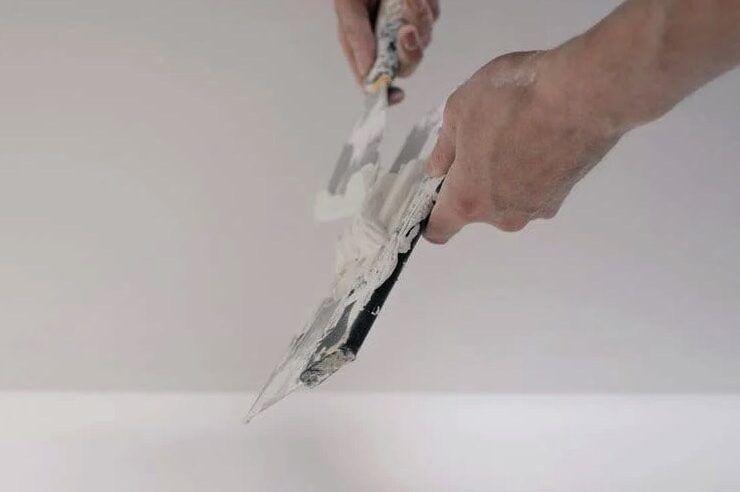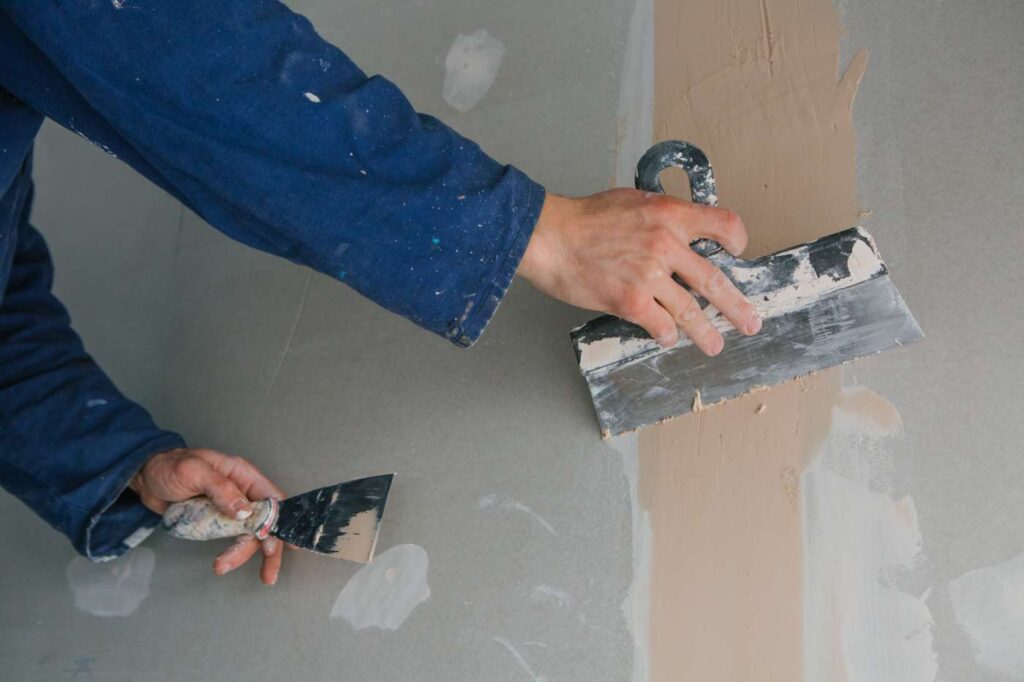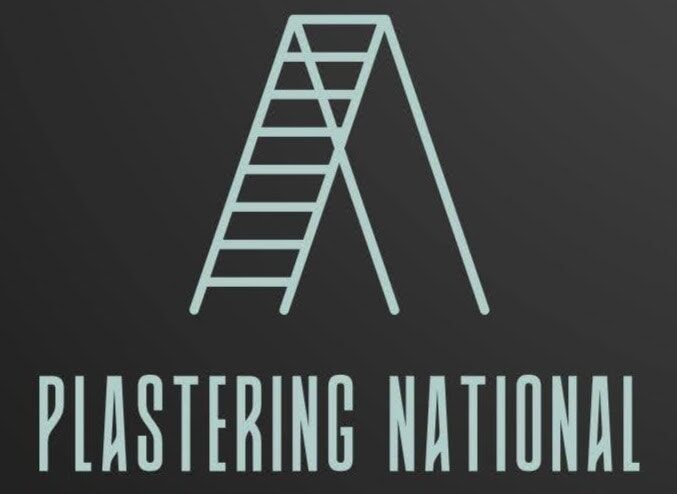The walls of a historic house are often built of plaster and lath. Depending on the context, they can be both beautiful and frustrating. Drywall, a more modern and convenient wall covering, began to replace plaster, which had been in use for centuries, in the middle of the 1940s.
They might be quite pleasant or very annoying, depending on the situation. Knowing the pros and cons of plaster walls is essential.
It’s helpful to have an understanding of what a plaster wall is, as well as the benefits and drawbacks of this classic wall covering, whether it’s something that annoys or motivates you.
Knowing the difference between drywall and plaster, as well as the best way to repair holes and patch them, and how to troubleshoot WIFI issues and solutions, will help you navigate a number of potential snags.
Plaster has two main benefits, both of which are related to its physical and chemical properties: it slows the spread of fire and it muffles noise.
In addition, it offers your home a one-of-a-kind, personalised appearance that is both modern and retro at the same time. Because so few people use it, it’s a simple way to inject your home with style and create a statement.
Plaster isn’t as sturdy as it’s made out to be, and it can become loose and break along walls very easily. Poor workmanship, improper application, or excess moisture can also cause the material to crack or come loose from the framework.
Plaster repair or removal can be time consuming and costly, but small cracks can be quickly mended with do-it-yourself solutions.

The Pros and Cons of Plaster Walls
Plaster is a great alternative to smooth paint if you want to add depth and dimension to a room. Plaster can be used for both wall and ceiling finishing. We can also consider plaster backsplashes, but first we need weigh the pros and cons.
Plastering walls has been a standard building practise for centuries. Drywall didn’t start replacing it until the 1940s. Plastered walls can be stunning or frustrating, depending on your point of view. Plaster is applied to walls by highly skilled workers using a trowel or hawk. Plastering a wall might take up to 30 days to cure.
When it comes to interior wall finishing, plaster used to reign supreme. Once drywall was readily available, however, it all changed.
You could assume that modern plasters can only be found in restored homes and museums. However, you’re wrong. There are many modern applications for this old substance.
Simply put, what is a Plaster Wall?
When you add water to dry powder, it turns solid. For a flawless finish on brick, block, or concrete, gypsum is your best bet.
Prior to painting, a layer of plaster about 6 mm thick would typically be applied over the cement plaster. It’s a two-step procedure that calls for various materials including sand, cement, and water to be mixed together in the construction site.
One coat of plaster applied directly to the surface is slowly replacing this procedure. He applies gypsum plaster, a dry powder that has already been combined with water, directly to the wall.
Plaster on Walls as a Living System
Skilled plasterers can quickly apply the finishing touches to walls using tools like birds of prey and scoops. This caused delays in the construction schedule because it took a plaster wall up to a month to heal completely (or longer in colder climates) before it could be painted.
Plaster was applied to an existing flat surface upon which traditional wood slats had been fastened to the studs, with 1/4″ holes left between each slat. By pressing through this opening, the plaster would create a “key” that, once dry, would hold the plaster to the wall.
Over time, a variety of other types of strips gained popularity, such as metal slat, which is still used as a base for plaster applications, and rock slat, which was the inspiration for drywall. During the 1940s and 1950s, “rock slat,” or 2×8 sheets of early drywall, were often used to cover the studs before plaster was applied.
Common practise called for applying three coats of plaster to a wall. The initial “scratch coat,” a mixture of lime, sand, and water, was applied to the slat and scratched using hand tools to ensure a firm hold for the second “earthy-colored coat.”
When the scratch coat had dried, the earth tone coat was applied in a similar fashion by scooping it on between 1/4 and 3/8 inch thick and letting it dry. In contrast to the first two coats, which were sometimes skipped over in cheaper projects, the third and final coat, known as the skim or finishing coat, was put to a thickness of just 1/8″ or something comparable.
Lime and water were once used to make the skim coat, but beginning in the middle of the twentieth century, gypsum replaced lime plasters as the material of choice due to its rapid drying time.
Wall Plaster Depth
It’s effective on substrates between 6 and 20 mm thick. For comparison’s sake, the base coat of plaster is typically 11 mm thick for walls and 8 mm thick for ceilings, while the finish coat is typically 2 mm thick.
For optimal crack prevention, use gypsum plaster at a thickness of 6 mm. For walls that need more than 20 mm of plaster, it is advised to apply a cement sand plaster base coat of 8 to 12 mm, followed by a plaster finish coat of at least 6 mm.
Pros of Having Plaster Walls
Plastering walls has more benefits than you may have originally thought. In the eyes of these specialists, it is more cost-effective to have your plaster walls repaired than to remove them and replace them with drywall.
Comparatively, Plaster is a Sturdier Material
Solid plaster walls have much greater tensile strength than drywall. Try grinding cured plaster or poking a hole in it and you’ll see how much more difficult it is compared to drywall. A highly improbable occurrence. Dings, nicks, and dents in the drywall can be avoided because to its strength.
Fireproof and soundproof
Modern drywall is much quieter than lath and plaster, so it’s obvious when you walk in which room is which. Plaster’s irregular shapes give it this quality, making it a good soundproofing material. Similarly, lime plaster is much denser than gypsum wallboard.
In addition, it is generally accepted that regular plaster materials deter fire. Carbonated lime will prevent the spread of fire better than drywall can. Furthermore, there is less space or air between the ceiling and the walls. Consequently, the flames may be getting less oxygen.
Save money on energy costs by using plaster
When it comes to saving money on heating and cooling costs, a thicker wall is the way to go. In terms of energy efficiency, thicker plaster walls are preferable than thinner drywall walls because they give better thermal breaks. Plaster walls are nearly twice as thick as drywall applications, coming in at around 7/8 inches. An extra thick plaster wall provides better thermal breaks than drywall. Since this is the case, you can expect lower utility costs.
Artistry
Drywall, in its simplest definition, is a flat wall covering.
Even though you can decorate it with paint or wallpaper, it doesn’t have much going for it. Any unique architectural details can be constructed on top of the drywall, but other construction materials will be required.
However, plaster can be easily shaped into any desired form.
Plaster specialists, therefore, are more akin to master craftsmen than to construction workers, as they must use great care and precision to create beautiful details and designs that will work with many different decors.
Plaster, for instance, was utilised to create many of the stunning features that are signature to Victorian houses, but it may also be used in contemporary renovations.
Plaster is considerably easier to work with than other materials when it comes to filling in little crevices and figuring out how to cover over unusual shapes.
Installation
Sanding and chopping drywall generates a great deal of fine particles of dust. Plasterboard finishing takes a long time since each coat of joint compound must dry before the next can be applied. It often takes a couple of days.
The only dust that may be created from plaster is the very minimal quantity that is released when the powder is mixed with water. The plaster also does not require sanding.
When compared to drywall, plaster walls could be installed more quickly and with less debris. Plastering a wall reduces the amount of mess left behind after construction.
Acoustics
The acoustics of plaster, for instance, are quite different from those of drywall.
Sound engineers and musicians often choose to record or play in rooms finished with plaster because of the richness of the resulting sound.
Plaster walls are better at blocking out noise, making them ideal for venues like concert halls and nightclubs.
In comparison to more porous materials, plaster has a much greater capacity to absorb sound because of its greater density and volume.
This wall covering is more securely attached to the wall frame than drywall is, resulting in less air space behind the wall covering. It also makes the material more fireproof and less likely to leak sound. Good acoustics and soundproofing would be helpful in a wide variety of settings, including restaurants, doctor’s offices, noisy warehouses, etc.
Superior Noise Insulation
Plaster outperforms drywall in soundproofing because of its chemical make-up, increased thickness, and increased hardness. If the wall is double the thickness, it should be able to at least double the amount of sound it blocks. Exceptional for seclusion, but horrible for eavesdropping.
Strong
Plaster has much more tensile strength than drywall. You could, for instance, try poking a hole in the wall.
To your utter dismay, it won’t. The durability of a plaster wall also makes it less susceptible to the dents, dings, and nicks that plague drywall.
When water evaporates from a plaster mixture, a chemical process takes place, strengthening the bonds between the particles. As a result, plaster is superior to other materials in terms of durability against dings and dents.
The lath or backing that is used to support the plaster also affects how long it will endure.
When compared to the thin wooden lath strips utilised in older homes, the durability of modern metal lath or solid supporting boards is vastly superior.

Versatility
Plaster is the best building material for renovations because of its malleability.
Drywall is one of the materials whose look and feel can be mimicked. If you want the benefits of plaster but need your reconstruction to be seamless, you can achieve both goals by using a material that closely matches the original.
Plaster can be used as a finishing material for virtually any part of a building. Ceiling tiles, arches, ornate vents, and fireplace mantels all benefit from plaster’s ability to be shaped and moulded into the perfect finish.
Any property owner has the option of giving their home’s or building’s interior and exterior a one-of-a-kind look. That’s why it’s so well-suited to high-end establishments like restaurants and boutiques, as well as homes where the proprietors value expressing their own unique sense of style.
The Cons of Plaster Walls
Everything, including plaster walls, has flaws. To be fair, it is only right to present both sides, as the aforementioned benefits do not come without drawbacks.
Bad Wi-Fi Connection
WiFi and cell phone signals cannot penetrate the thick plaster walls. A standard wireless router may not even work in a modest cottage with plaster walls.
If you want to get decent service in a house built in the 1920s with plaster walls, you’ll need to upgrade to a mesh system like Google WIFI.
Inconvenient to Fix
It’s not easy to fix plaster that has crumbled or split due to a hard blow or shifting foundations.
There should be no further harm to the wall materials when scraping or cutting the plaster.
If the damage is significant, you may need to replace the backing or lath.
Plaster also fades from its initial hue with time. As a result, further patches will become evident over time if you don’t paint the entire wall after mending it.
It’s possible that the wall will eventually crack
More and more effort is required to ensure that plaster walls fully cure. It gets brittle and eventually breaks as a result.
The combination of heavy foot and vehicle traffic and a lack of solid foundations makes for a perfect storm for the occurrence of cracks in these areas. Gravity pulls down on the ceiling, and plenty of footsteps from above could eventually cause it to crack and break.
Expense
Drywall is often far less expensive than plastering, despite the added labour necessary in hanging and finishing it. Plasterers, on the other hand, are able to charge more for their services because of the specialised knowledge they bring to the table.
Less Easy to Hang
Stronger plaster is trickier to drill or nail into, which makes it more difficult to decorate.
If you follow the advice in this earlier post, though, you can hang things on a plaster wall. Keep in mind that hammering in a nail into plaster walls may not do anything.
Conclusion
Knowing the difference between drywall and plaster might help you fix walls. Plaster can easily peel and fracture along walls. Skilled plasterers finish walls swiftly with birds of prey and scoops.
In the 1940s and 1950s, rock slats-2 x 8 sheets of early drywall-covered the studs. Plaster walls are stronger than drywall.
Drywall resists dents and dings. Carbonated lime helps contain fires by being solid and oxygen resistant. Plaster covers strange shapes and fills cracks better than other materials.
Plaster acoustics differ from drywall. Plasterboard finishing takes time since each layer of the joint compound must dry before the next.
Plaster’s versatility makes it perfect for rehabilitation. Its malleability lets it be employed in ceiling tiles, arches, decorative vents, and fireplace mantels.
The lath or backing used to apply plaster also affects its longevity. The wall may collapse. Drywall is cheaper than plastering.
Content Summary
- The walls of a historic house are often built of plaster and lath.
- It’s helpful to understand what a plaster wall is and the benefits and drawbacks of this classic wall covering, whether it’s something that annoys or motivates you.
- Knowing the difference between drywall and plaster, the best way to repair holes and patch them, and how to troubleshoot WIFI issues and solutions will help you navigate some potential snags.
- Plaster can be used for both wall and ceiling finishing.
- Highly skilled workers use a trowel or hawk to apply plaster to walls.
- Gypsum is your best bet for a flawless finish on brick, block, or concrete.
- One coat of plaster applied directly to the surface slowly replaces this procedure.
- He directly applies gypsum plaster, a dry powder that has already been combined with water, to the wall.
- Skilled plasterers can quickly apply the finishing touches to walls using tools like birds of prey and scoops.
- A common practice called for applying three coats of plaster to a wall.
- For comparison’s sake, the base coat of plaster is typically 11 mm thick for walls and 8 mm thick for ceilings, while the finish coat is typically 2 mm thick.
- For optimal crack prevention, use gypsum plaster at a thickness of 6 mm.
- In the eyes of these specialists, it is more cost-effective to have your plaster walls repaired than to remove them and replace them with drywall.
- Comparatively, plaster is a Sturdier Material. Solid plaster walls have much greater tensile strength than drywall.
- Similarly, lime plaster is much denser than gypsum wallboard.
- Carbonated lime will prevent the spread of fire better than drywall can.
- A thicker wall is the way to go when saving money on heating and cooling costs.
- In terms of energy efficiency, thicker plaster walls are preferable to thinner drywall walls because they give better thermal breaks.
- An extra thick plaster wall provides better thermal breaks than drywall.
- Plaster walls could be installed more quickly and with less debris than drywall.
- Plastering a wall reduces the amount of mess left behind after construction.
- The acoustics of plaster, for instance, are quite different from those of drywall.
- Plaster walls are better at blocking noise, making them ideal for concert halls and nightclubs.
- Plaster has a much greater capacity to absorb sound than more porous materials because of its greater density and volume.
- Good acoustics and soundproofing would be helpful in various settings, including restaurants, doctor’s offices, noisy warehouses, etc.
- Superior Noise Insulation Plaster outperforms drywall in soundproofing because of its chemical makeup, increased thickness, and hardness.
- As a result, plaster is superior to other materials in terms of durability against dings and dents.
- The lath or backing used to support the plaster also affects how long it will endure.
- Plaster is the best building material for renovations because of its malleability.
- If you want the benefits of plaster but need your reconstruction to be seamless, you can achieve both goals by using a material that closely matches the original.
- Plaster can be used as a finishing material for virtually any part of a building.
- Any property owner can give their home’s or building’s interior and exterior a one-of-a-kind look.
- WiFi and cell phone signals cannot penetrate the thick plaster walls.
- If you want decent service in a house built in the 1920s with plaster walls, you’ll need to upgrade to a mesh system like Google WIFI.
- There should be no further harm to the wall materials when scraping or cutting the plaster.
- If the damage is significant, you may need to replace the backing or lath.
- The combination of heavy foot and vehicle traffic and a lack of solid foundations makes for a perfect storm for cracks in these areas.
- Drywall is often far less expensive than plastering, despite the added labour necessary in hanging and finishing it.
- Stronger plaster is more tricky to drill or nail into, which makes it more difficult to decorate.
- If you follow the advice in this earlier post, you can hang things on a plaster wall.
- Remember that hammering a nail into plaster walls may not do anything.
Frequently Asked Questions About Plaster Wall
What Are the Uses of Plaster?
Plaster is a pasty composition (as of lime or gypsum, water, and sand) that hardens on drying and is used for coating walls, ceilings, and partitions. Plastering is one of the most ancient building techniques.
Is Plaster Better Than Cement?
And concrete has some unique properties when it comes to strength. For instance, concrete is one of the only forms of material that is not chemically reactant. On the other hand, plaster has survived for centuries, making it considerably more durable than other building materials.
Are Plaster Walls Expensive?
True, plaster walls are more expensive than painted drywall; they’re more labour-intensive to install (most require at least three coats). But they’re also typically longer lasting and more beautiful.
How Toxic Is Plaster?
Plaster or Gypsum (Calcium Sulfate Dihydrate) is a non-toxic agent that can release nuisance dust in handling or use. It may affect the eye, skin, nose, throat and upper respiratory tract. Prolonged and repeated exposure can result in lung disease (i.e., silicosis) and lung cancer.
Are Plasters Flammable?
Plaster does not combust and cannot be set on fire. Although it has a low chemical reactivity, it can act as an oxidising agent in extreme circumstances. At high temperatures, it decomposes, releasing poisonous sulphur oxides. It reacts exothermically but slowly with moisture in the air or water to make gypsum.

